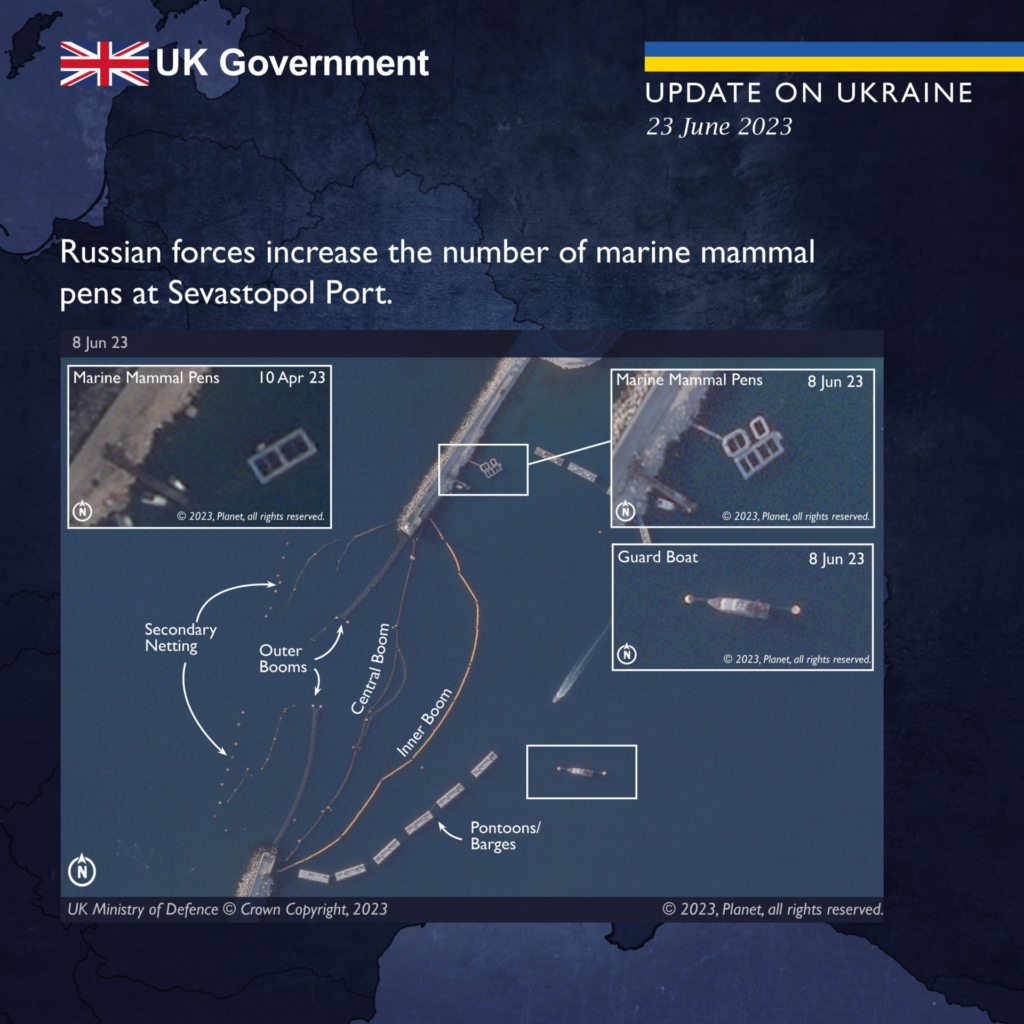A bizarre Cold War throwback emerges as new intelligence claims Russia has deployed an “increased number” of military dolphins to its naval base in Crimea meant to attack human saboteurs.
Russia has been reinforcing its Black Sea naval base, says the United Kingdom’s Ministry of Defence (MOD), since the country launched another invasion of Ukrainian territory in 2022. While many of the defences deployed are conventional including nets and booms to catch torpedos, submarines, and surface ships, others are somewhat less so, including the deployment of military dolphins.

Ministry of Defence / Twitter
Satellite photos reveal, the MOD says, “a near doubling of floating mammal pens in the harbour” in recent weeks. These pens, they say are likely to be the home to bottle-nosed dolphins trained to “counter enemy divers”, in other words, to attack unauthorised visitors.
Discussing Russia’s earlier use of dolphins to protect its naval base in the Black Sea from enemy divers, King’s College London academic Professor Andy Lambert said last year: “Dolphins would be ideal for killing human divers … fast, clever, and powerful”. The report also notes that, unlike a warship, dolphins are not magnetic and don’t risk setting off proximity mines.
Russia has stationed its Black Sea fleet in Sevastopol on the Crimean Peninsula for nearly 250 years, even after Crimea became a Ukrainian, post-Soviet territory at the end of the Cold War. Indeed, the return to prominence of military mammals in the Black Sea now has a Cold War flavour to it, as forces on both sides of the Iron Curtain attempted to train whales, dolphins, and seals to perform military tasks.
The MOD notes the Russian navy still uses beluga whales and seals in arctic waters to this day, and a suspected Russian-trained “spy whale” with a camera harness has been turning up in northern European ports in recent months. A 2016 report noting that Russia was seeking to buy five dolphins to reinvigorate its dolphin training programme also published the remarks of an ex-Soviet Colonel who witnessed the training of the animals by Russia during the Cold War.
Colonel Viktor Baranets said dolphins were trained to plant explosives on ships.
The United States denies its own dolphin training programme in San Diego, California has a violent element to it, as the Russian one is alleged to. Instead, the U.S. Navy says its now-declassified but ongoing programme has trained dolphins to find and alert human handlers to underwater mines since 1959. Per the Naval Warfare Information Centre:
Dolphins naturally possess the most sophisticated sonar known to science. Mines and other potentially dangerous objects on the ocean floor that are difficult to detect with electronic sonar, especially in coastal shallows or cluttered harbors, are easily found by the dolphins. Both dolphins and sea lions have excellent low light vision and underwater directional hearing that allow them to detect and track undersea targets, even in dark or murky waters. They can also dive hundreds of feet below the surface, without risk of decompression sickness or “the bends” like human divers. Someday it may be possible to complete these missions with underwater drones, but for now technology is no match for the animals.
Recovering objects in harbors, coastal areas, and at depth in the open sea, sea lions locate and attach recovery lines to Navy equipment on the ocean floor. Dolphins are trained to search for and mark the location of undersea mines that could threaten the safety of those on board military or civilian ships. Both dolphins and sea lions also assist security personnel in detecting and apprehending unauthorized swimmers and divers that might attempt to harm the Navy’s people, vessels, or harbor facilities.


